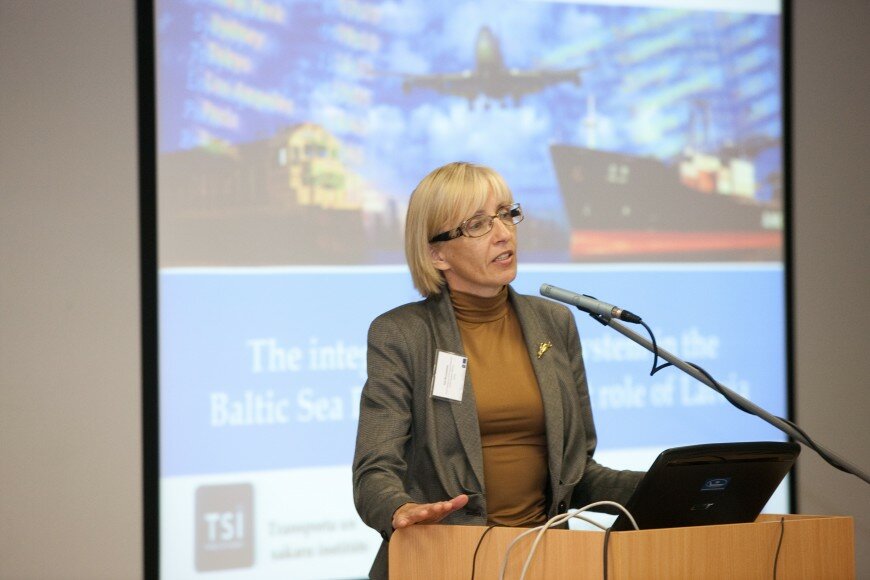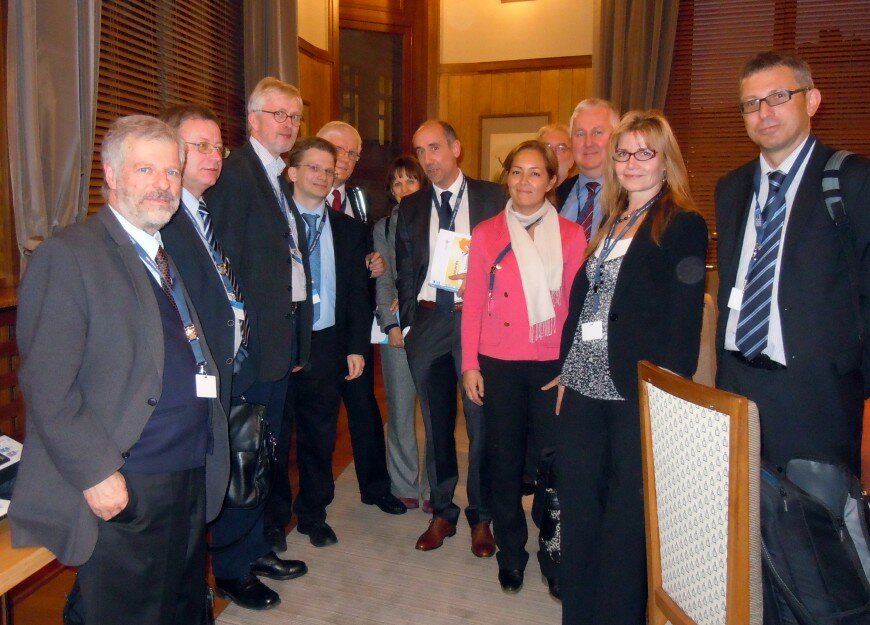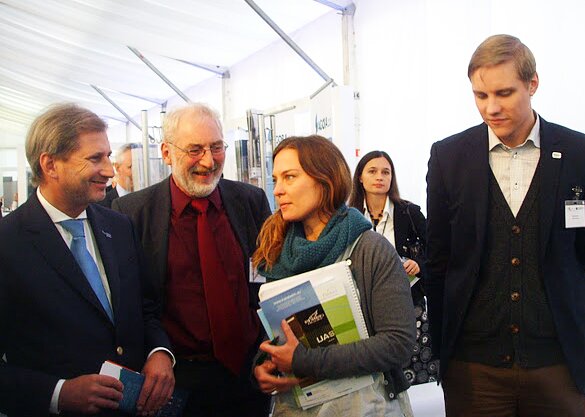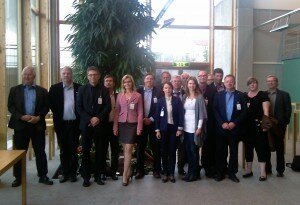Allied transport projects in a promising dialogue with DG MOVE at the TEN-T Days
Published: 2011-12-01 21:56
The European Commission arranged for the fourth time a conference dedicated to the Trans European Transport Network (TEN-T). Representatives from the Commission, the EU Parliament, national ministries and many other stakeholders met for the last two days of November in Antwerp, to discuss the new TEN-T framework with the revised guidelines and the “Connect Europe Facility (CEF)” proposal as an integrated instrument for investments in EU infrastructure priorities in Transport, Energy and Telecommunications summing up to 50 billion EUR for 2014-2020.
In times of ongoing economic crisis those three components are considered the cornerstones in achieving the “Europe 2020” overarching goal of “growth” and the CEF proposal has the intention to harmonise the three sectors. As the revised TEN-T guidelines have changed approach from a former patchwork of infrastructure priorities to a connected network covering all EU member states in a dual layer of a Core network to be established by 2030 and a Comprehensive network to be realised by 2050, a regional perspective is still of importance. TranBaltic together with allied transnational transport projects in the BSR & NSR Programme got the opportunity for a private discussion with Mr Jean-Eric Paquet, Director, European Mobility Network/DG MOVE, as a follow up to the sent letter of intent from the alliance expressing their will to assist in the development focusing on the green transport corridors as a measure to combine the optimised performance of multimodal supply chains with sustainable regional growth and territorial cohesion. Mr Paquet welcomed the initiative, expressing his wish to see Interreg projects involved in the process and recommended the group to continue the discussions with his colleagues at DG MOVE, with a first meeting for such cooperation to take place at TransBaltic Umbrella seminar hosted by NDPTL in Helsinki, 27 Jan 2012.
TransBaltic Newsletter No. 13
Published: 2011-11-25 12:07
Download: TransBaltic Newsletter No 13
In this issue –
- Emergency terminals for rail freight transport - Lack of confidence in railways’ ability to deliver acceptable quality of freight transport is one of several reasons for the small volumes of rail freight transport between Norway and other countries in the Baltic Sea Region. Representatives of key stakeholders in rail freight transport are now, within the framework of TransBaltic, working in close cooperation on procedures that might help customers to access to their containers in case of severe delays.
- Enabling intermodal connections between Poland and Scandinavia – The BSR transport system is going through changes due to huge infrastructure investments in fixed connections as the Øresund Bridge or the planned Fehmarn Belt Link which will increase the competitiveness of rail transport significantly on trade lanes linking Sweden and Denmark with the German transport networks, yet remains the profile of the transport system between Poland and Sweden unchanged still relying on traditional ro-ro ferry connections. A study performed by TransBaltic partner ILiM describes the potential of and the necessary steps for enabling regular intermodal connections between the main business centres in Poland and Sweden/Norway.
- Filling an important gap – While the newly launched TEN-T regulation proposal argues for a complete trans-European transport network to ensure the smooth functioning of the internal market and strengthening economic and social cohesion, the coordinated action of the national transport ministries around the Baltic Sea (Baltic Transport Outlook) delivers a plan for a strategic transport network in a macroregional context. As a complement TransBaltic presents a subregional perspective and project transport trends by 2030 with special attention to a green scenario highlighting the green corridor initiatives striving for a sustainable development within the Baltic Sea region also connecting it with the outside world. The article presents a unique estimation of transcontinental flow volumes in 2030 from the Far East destined for BSR and their distribution on different rout alternatives.
A guide to successful implementation of Dry Ports
Published: 2011-11-07 14:16
Region Västerbotten has within the scope of TransBaltic conducted a study of the dry port concept in the context of successful establishment in Västerbotten/Sweden. The report describes the constitution of a profitable dry port in Scandinavia and the necessary market conditions for successful implementation of the concept with special attention to the specificity of Region Västerbotten and the two potential dry port sites “The Nordic Logistic Center” in Umeå and the terminal in Stensele. Designing and implementing intermodal terminals is a complex process involving both public and private actors. The study identifies key factors and actors in the development process and describes how these interact and affect the progress and overall status of the process as well as describes the current trend and challenges related to the road-rail intermodal transport segment.
Download the report here.
Strategic transport projects joint vision attracted attention at the EU Baltic Sea Strategy Forum
Published: 2011-10-28 13:46
Being part of the flagship project “Cooperation for smarter transport” of the EU Strategy for the Baltic Sea Region, the four strategic transport projects TransBaltic, East-West Transport Corridor II (EWTC II), Rail Baltica Growth Corridor (RBGC) and Scandria were given the opportunity to present their joint vision during the European Commission’s 2nd Annual Forum on the EU Strategy for the Baltic Sea Region in Gdansk, Poland, 24-26 October 2011. The projects hosted a joint forum together with the Swedish Ministry of Enterprise, Energy & Communications back-to-back with the main event inviting stakeholders to discuss Green Corridors with focus on the projects’ various solutions for more efficient transport, such as information broker system, bio-gas corridor, an internet platform for planning of intermodal transport and rail connections in the Baltic states. To enhance the message of their joint vision and efforts for a Baltic Sea Region connected to Europe and future global markets acting as facilitator of sustainable transport solutions worldwide the four projects shared a stand at the main forum exhibition. The stand attracted visitors like Johannes Hahn, EU-Commissioner for Regional Policy and Dirk Ahner, Director General of DG Regio, proving the importance of the transnational transport projects’ input to the Baltic Sea Strategy.
TRANSBALTIC NEWSLETTER NO. 12
Published: 2011-10-28 07:14
Download: TransBaltic Newsletter No 12
In this issue –
- The integrated transport system in the Baltic Sea region – the transit role of Latvia. – The transport sector should be perceived as a whole, rather than separate industries and logistics connections. Still the transport network in the EU must not only be united, but also green, as the environmentally friendly approach hits the big time. The TransBaltic Stakeholders Debate, held in Riga on 14th of September, was devoted to the holistic and green development of European transport, with special attention to the transit role of Riga.
- Inland waterway transport in the BSR – time to take action. – As transport needs are growing, while restrictions in the transport sector are increasing in number, the development of inland water transport (IWT) in the Baltic Sea region is an undeniable chance to meet market demands and to boost the region’s competitiveness on an international scale. A recent TransBaltic report gives an insight into the present state of the inland transportation system in the BSR and shows the importance of integrating IWT into the system as well as proposes actions in order to do so.
Transport projects to assist in the TEN-T planning
Published: 2011-10-03 13:38
A letter addressed to the Director of “Trans-European Transport Network and Smart Transport” at the European Commission’s DG MOVE was sent last week signed by several project managers of transnational projects from both North Sea Region Programme and the Baltic Sea Region Programme.
As a result of the frequent umbrella meetings and cooperation scheme, TransBaltic together with Amber Coast Logistics, Bothnian Green Logistics Corridor, BSR InnoShip, EWTCII, NECLII, Rail Baltica Growth Corridor, Scandria and StratMos agreed to sign a joint letter of intent offering the European Commission assistance in developing the green transport network of the European Union by providing their knowledge, experience and networks. The scope of the joint work by above mentioned projects correlates well with the corridor approach promoted by the Commission in the TEN-T planning work, focusing on the green transport corridors as a measure to combine the optimised performance of multimodal supply chains with sustainable regional growth and territorial cohesion.
View the letter here: Joint letter of intent for the green transport network development
Latvia aspires to serve the transcontinental flows
Published: 2011-09-27 16:04

Inta Rozensteine - Deputy Director of Financial Management & Development Dep, Latvian Ministry of Transport
“Co-ompetition is the key to future successful development” Igor Kabashkin, President of the Transport and Telecommunications Institute in Riga, declared when presenting the prospects of Latvia’s transport transit role. Some 50 participants joined the discussion when TransBaltic invited to debate the subject in Riga.
Alongside Estonia and Lithuania, Latvia is mobilising the forces not to be left off the map when the growing Asian economies plan their future transport routes. Inta Rozensteine, Latvian Ministry of Transport, announced that the Ministry, in the planning stage of the national transport policy 2014-2020, is much aware of the importance of attracting these transit flows to secure a positive economic development, while keeping references to the European Commission’s White Paper.
Latvia has the advantage of bordering to both Russia and Belarus and the institutionalised customs union between these two neighbouring countries and Kazakhstan is perceived an excellent opportunity to attract the freight flows. Development of logistics and distribution centres could also be on the agenda with the value added production in the customs free zones.
Competition between the three Baltic States is, however, not a desirable outlook. While rivalling for funding to develop TEN-T infrastructure links and green transport technologies, Latvia, Lithuania and Estonia can still cooperate to harmonise planning concepts and develop their own profiles as transit countries. Thus, co-ompetition at relevant governance levels and across the territories could be more suitable as a means to find a right focus in transport policy planning.
Click here to see a live coverage from the event.
Securing a common vision
Published: 2011-09-21 13:30
The allied transport projects met again to give a progress update on their various analyses, strategies, action plans and manuals, and to brainstorm on key performance indicators for green transport corridors. The cooperation scheme that originally included TransBaltic, EWTCII and Scandria has now 9 participating projects with Rail Baltica Growth Corridor, NECL II (Midnordic Green Transport Corridor), Bothnian Green Logistic Corridor, StratMoS and BSR InnoShip – a set up that resembles the Maritime Transport Cluster cooperation scheme, recently launched in the North Sea Region Programme.
Seeing the importance of the gathered competence in the umbrella cooperation, the Baltic Transport Outlook (BTO) Secretariat agreed to a notion of a joint seminar, with the BTO Steering Committee members attending, to discuss the content of the draft final Baltic Transport Outlook study and the way the umbrella projects could assist in further dissemination of the BTO results after the study is finalised in late 2011.
In general discussion on streamlining the various transport planning processes, a significant role was attributed to the Northern Dimension Partnership on Transport and Logistics (NDPTL), which is deemed a relevant arena to debate the findings of both the BTO and the umbrella projects at the overall BSR level, with participation of the EU neighbouring countries.
The meeting, being the first occasion for the three parties to exchange information and share ideas for collaboration, saw also some other benefits – an opportunity to harmonise visions on the future transport networks in the Region. As BTO strives to create a BSR-specific strategic network, complementary to the Commission’s TEN-T core and comprehensive network, the NDPTL aspires to do likewise, with active participation of Russia and Belarus. In that respect, the umbrella projects orientate themselves to develop a green transport network, with services, technologies and education issues added to the infrastructure layer. For that reason the projects agreed to sign a joint letter of intent to DG MOVE offering assistance in developing the green transport network of the European Union, based on accumulated knowledge, experience and links to relevant stakeholders in the BSR transport corridors.
TransBaltic Newsletter No. 11
Published: 2011-08-30 16:08
Download: TransBaltic Newsletter No 11
In this issue –
- The future of small ports – What are the development perspectives for small and medium Baltic Sea ports? The article summarizes discussions on the topic from a seminar that took place in Elblag in June featuring speakers from port authorities, research sector and ports around the Baltic Sea. The article also features some insight to the special case of Port Elblag. A more extensive report from the seminar is available here.
- A hotspot for empty flows – The share of empty boxes of all containers transported in the Baltic Sea Region (21%-26% between 2005 and 2009) is above global and European average. Hamburg University of Technology has made a study on the subject in dialog with transport and terminal operators providing some insights from the industry. The study in its full is available here.
Report from TransBaltic 2011 Conference
Published: 2011-07-08 15:24
100 participants from 12 countries gathered in Sweden/Skellefteå in May for TransBaltic Conference 2011 – “A model region for green transport solutions” to discuss transport and infrastructure in the Baltic Sea Region focusing on the region’s internal connectivity and its external accessibility. Invited speakers from the region as well as from India and North America inspired to animated discussions between the audience and the panels featuring pan-Baltic organisations and TransBaltic stakeholders. What do we need to consider when preparing for a green future, what is crucial in achieving this and what policy measures do we require?
A report summarizing the two day long conference with highlights from presentations and discussions is now available. Download the report here.
The conference did not only highlight transport and infrastructure issues but did also draw some attention to the northern parts of Sweden. The municipality of Skellefteå took the opportunity to invite the conference participants for an evening to remember letting them experience what the region has got to offer visitors.
Click on the link to view a film clip from the evening reception: “TransBaltic in Skellefteå on YouTube”


